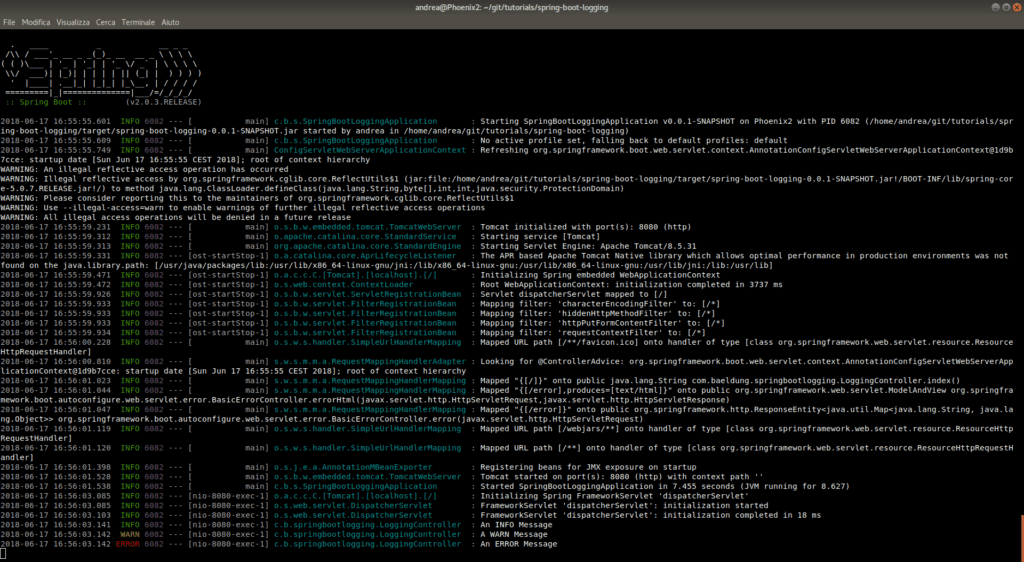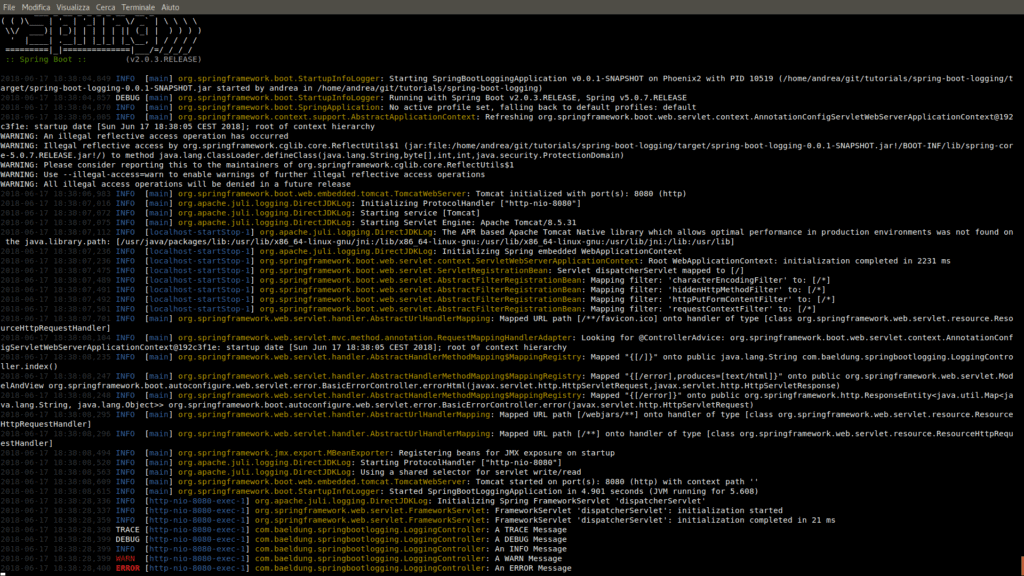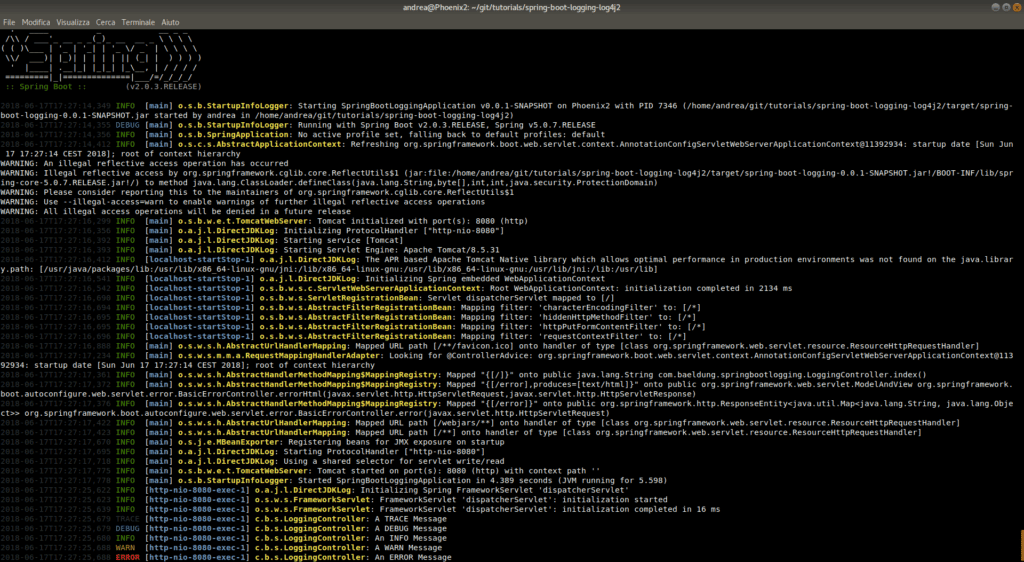1. 概述
本文将深入探讨 Spring Boot 中主流的日志方案。你会了解到如何配置 Logback 和 Log4j2,如何通过 Lombok 简化日志代码,以及一些常见“踩坑”点。
如果你需要更深入掌握 Logback,推荐阅读《Logback 使用指南》;而关于 Log4j2 的核心组件(Appender、Layout、Filter),可参考《Log4j2 入门指南》。
2. 初始项目搭建
使用 Spring Initializr 快速生成一个 Spring Boot 项目是最推荐的方式,具体步骤可参考我们的《Spring Boot 快速入门》。
创建一个核心类 LoggingController 来演示日志输出:
@RestController
public class LoggingController {
Logger logger = LoggerFactory.getLogger(LoggingController.class);
@RequestMapping("/")
public String index() {
logger.trace("A TRACE Message");
logger.debug("A DEBUG Message");
logger.info("An INFO Message");
logger.warn("A WARN Message");
logger.error("An ERROR Message");
return "Howdy! Check out the Logs to see the output...";
}
}
启动应用后,访问 http://localhost:8080/ 即可触发日志输出,查看控制台即可看到结果。
3. 零配置日志(Zero Configuration Logging)
Spring Boot 的设计哲学之一就是“约定优于配置”,日志系统也不例外。你几乎不需要任何配置就能跑起来。
3.1 默认使用 Logback
✅ 关键点:只要引入了任意一个 Spring Boot Starter(比如 spring-boot-starter-web),就会自动引入 spring-boot-starter-logging,它默认集成的是 Logback。
底层依赖的是 Spring 自带的 spring-jcl(Spring Java Commons Logging),你完全不需要手动引入。
启动应用后访问首页,控制台输出如下:
⚠️ 注意:默认日志级别是 INFO,因此 TRACE 和 DEBUG 级别的日志不会显示。
如果想临时开启更详细的日志,可以使用命令行参数:
java -jar target/spring-boot-logging-0.0.1-SNAPSHOT.jar --trace
或者 --debug,Spring Boot 会自动调整日志级别。
3.2 日志级别控制
Spring Boot 提供了多种方式来精细化控制日志级别:
方式一:JVM 参数
-Dlogging.level.org.springframework=TRACE
-Dlogging.level.com.baeldung=TRACE
方式二:Maven 命令行
mvn spring-boot:run \
-Dspring-boot.run.arguments=--logging.level.org.springframework=TRACE,--logging.level.com.baeldung=TRACE
方式三:Gradle 命令行
./gradlew bootRun -Pargs=--logging.level.org.springframework=TRACE,--logging.level.com.baeldung=TRACE
方式四:application.properties
logging.level.root=WARN
logging.level.com.baeldung=TRACE
方式五:日志框架配置文件(如 logback-spring.xml)
<logger name="org.springframework" level="INFO" />
<logger name="com.baeldung" level="INFO" />
✅ 优先级规则:如果同一包的日志级别在多个地方被设置,最终生效的是级别最低的那个(TRACE < DEBUG < INFO < WARN < ERROR)。例如,一处设 INFO,另一处设 TRACE,则最终为 TRACE。
4. Logback 自定义配置
默认配置适合快速验证,但生产环境需要更精细的控制,比如:
- 区分控制台和文件输出
- 自定义日志格式和颜色
- 文件滚动策略(按时间/大小)
配置文件加载机制
Spring Boot 会自动加载 classpath 下的以下文件(按优先级):
logback-spring.xml✅ 推荐使用,支持 Spring Profilelogback.xmllogback-spring.groovylogback.groovy
官方文档明确建议使用 -spring 后缀变体。
示例:logback-spring.xml
<?xml version="1.0" encoding="UTF-8"?>
<configuration>
<property name="LOGS" value="./logs" />
<appender name="Console"
class="ch.qos.logback.core.ConsoleAppender">
<layout class="ch.qos.logback.classic.PatternLayout">
<Pattern>
%black(%d{ISO8601}) %highlight(%-5level) [%blue(%t)] %yellow(%C{1.}): %msg%n%throwable
</Pattern>
</layout>
</appender>
<appender name="RollingFile"
class="ch.qos.logback.core.rolling.RollingFileAppender">
<file>${LOGS}/spring-boot-logger.log</file>
<encoder
class="ch.qos.logback.classic.encoder.PatternLayoutEncoder">
<Pattern>%d %p %C{1.} [%t] %m%n</Pattern>
</encoder>
<rollingPolicy
class="ch.qos.logback.core.rolling.TimeBasedRollingPolicy">
<!-- 每天或文件达到 10MB 时滚动 -->
<fileNamePattern>${LOGS}/archived/spring-boot-logger-%d{yyyy-MM-dd}.%i.log</fileNamePattern>
<timeBasedFileNamingAndTriggeringPolicy
class="ch.qos.logback.core.rolling.SizeAndTimeBasedFNATP">
<maxFileSize>10MB</maxFileSize>
</timeBasedFileNamingAndTriggeringPolicy>
</rollingPolicy>
</appender>
<!-- 根日志器:INFO 级别 -->
<root level="info">
<appender-ref ref="RollingFile" />
<appender-ref ref="Console" />
</root>
<!-- com.baeldung 包:TRACE 级别,关闭累加性 -->
<logger name="com.baeldung" level="trace" additivity="false">
<appender-ref ref="RollingFile" />
<appender-ref ref="Console" />
</logger>
</configuration>
运行效果:
可以看到,日志已按配置输出到控制台和 ./logs/ 目录,并启用了滚动归档。
5. 切换到 Log4j2
虽然 Logback 是默认选项,但 Log4j2 在性能和功能上更具优势(如异步日志)。切换步骤如下:
步骤一:排除默认日志依赖
<dependency>
<groupId>org.springframework.boot</groupId>
<artifactId>spring-boot-starter-web</artifactId>
<exclusions>
<exclusion>
<groupId>org.springframework.boot</groupId>
<artifactId>spring-boot-starter-logging</artifactId>
</exclusion>
</exclusions>
</dependency>
<dependency>
<groupId>org.springframework.boot</groupId>
<artifactId>spring-boot-starter-log4j2</artifactId>
</dependency>
步骤二:添加 log4j2-spring.xml
<?xml version="1.0" encoding="UTF-8"?>
<Configuration>
<Appenders>
<Console name="Console" target="SYSTEM_OUT">
<PatternLayout
pattern="%style{%d{ISO8601}}{black} %highlight{%-5level }[%style{%t}{bright,blue}] %style{%C{1.}}{bright,yellow}: %msg%n%throwable" />
</Console>
<RollingFile name="RollingFile"
fileName="./logs/spring-boot-logger-log4j2.log"
filePattern="./logs/$${date:yyyy-MM}/spring-boot-logger-log4j2-%d{-dd-MMMM-yyyy}-%i.log.gz">
<PatternLayout>
<pattern>%d %p %C{1.} [%t] %m%n</pattern>
</PatternLayout>
<Policies>
<OnStartupTriggeringPolicy />
<SizeBasedTriggeringPolicy size="10 MB" />
<TimeBasedTriggeringPolicy />
</Policies>
</RollingFile>
</Appenders>
<Loggers>
<Root level="info">
<AppenderRef ref="Console" />
<AppenderRef ref="RollingFile" />
</Root>
<Logger name="com.baeldung" level="trace" />
</Loggers>
</Configuration>
运行效果:
✅ 输出风格与 Logback 明显不同,确认已成功切换。
📌 扩展:Log4j2 还支持 YAML 和 JSON 配置,详见官方文档。
6. 直接使用 Log4j2(绕过 SLF4J)
上述配置中,日志仍通过 SLF4J API 输出。如果你想使用 Log4j2 的原生 API(如结构化日志、异步日志等高级特性),可以直接调用:
import org.apache.logging.log4j.Logger;
import org.apache.logging.log4j.LogManager;
@RestController
public class NativeLog4j2Controller {
private static final Logger logger = LogManager.getLogger(NativeLog4j2Controller.class);
@RequestMapping("/native")
public String index() {
logger.trace("A TRACE Message");
logger.debug("A DEBUG Message");
// ... 其他日志
return "Using native Log4j2 API";
}
}
⚠️ 缺点:代码与 Log4j2 强耦合,未来切换日志框架需要重写。
7. 使用 Lombok 简化日志代码
每次手动声明 Logger 实例很繁琐。Lombok 可以通过注解自动生成。
7.1 添加依赖
<dependency>
<groupId>org.projectlombok</groupId>
<artifactId>lombok</artifactId>
<version>1.18.30</version>
<scope>provided</scope>
</dependency>
7.2 常用注解
@Slf4j(推荐)
使用 SLF4J API,底层可自由切换 Logback 或 Log4j2。
@RestController
@Slf4j
public class LombokLoggingController {
@RequestMapping("/lombok")
public String index() {
log.trace("A TRACE Message");
log.debug("A DEBUG Message");
// ...
return "Check logs";
}
}
@CommonsLog
生成 org.apache.commons.logging.Log 实例,兼容性好。
@Log4j2
直接使用 Log4j2 原生 API,生成 org.apache.logging.log4j.Logger 实例。
@RestController
@Log4j2
public class LombokLoggingController {
// log 已自动生成
}
✅ 建议:日常开发推荐 @Slf4j,兼顾简洁与灵活性。
8. 警惕 Java Util Logging
Spring Boot 支持通过 logging.properties 使用 JDK 自带的 java.util.logging,但强烈不推荐。
⚠️ 原因:
- 在可执行 JAR 包中存在类加载问题
- 功能弱,配置繁琐
- 与主流框架集成差
📌 Spring 4 项目需手动排除 commons-logging 避免冲突;Spring 5+ 已自动处理。
9. Windows 下的 ANSI 颜色支持(JANSI)
Linux/macOS 终端天然支持 ANSI 颜色,但 Windows CMD 默认不支持。
解决方案:JANSI
Logback 配置
<configuration>
<appender name="STDOUT" class="ch.qos.logback.core.ConsoleAppender">
<withJansi>true</withJansi>
<encoder>
<pattern>[%thread] %highlight(%-5level) %cyan(%logger{15}) - %msg %n</pattern>
</encoder>
</appender>
</configuration>
Log4j2 配置
从 Log4j2 2.10 开始,JANSI 不再默认启用。需显式添加依赖并设置:
<!-- 添加 jansi 依赖 -->
<dependency>
<groupId>org.fusesource.jansi</groupId>
<artifactId>jansi</artifactId>
<version>2.4.0</version>
</dependency>
并在 log4j2.xml 中确保未设置 log4j.skipJansi=true。
⚠️ 注意:
- JANSI 依赖本地库,只能被一个类加载器加载,Web 应用需将 JAR 放在容器 classpath
- Spring Boot 的 Banner 仍为黑白,不受 JANSI 影响
10. 总结
本文系统梳理了 Spring Boot 日志体系的核心要点:
- ✅ 默认方案:
spring-boot-starter-logging+ Logback,开箱即用 - ✅ 生产推荐:切换至 Log4j2,性能更优,功能更强
- ✅ 代码简化:使用 Lombok
@Slf4j消除样板代码 - ❌ 避免踩坑:慎用 JUL,注意 Windows 颜色支持限制
所有示例代码已托管至 GitHub:https://github.com/dev-example/spring-boot-logging


